Module8PhotosTeachingPlan教学设计教案
九年级英语上册 Module 8 Photos单元精品教案 外研版

Module 8 Photos I. Teaching goals 模块教学目标II. Teaching material analyzing 教材分析本模块以“photos”为话题,学习描述摄影比赛和照片的表达方式。
通过模块学习,学生将重点掌握由who 和which 引导的定语从句,并能运用所学知识介绍照片。
Unit 1 通过听、读、说训练,初步学习谈论摄影比赛的方法。
Listening and vocabularyActivity 1要求看图片用所给词简单描述图片,初步学习这些新词。
Activity 2听录音检查答案。
Activity 3听读一段在校舞会现场谈论摄影的对话,初步了解由who 和which 引导的定语从句。
Activity 4根据对话回答问题,听对话录音核对答案,进一步加强对对话的理解。
Activity 5根据对话内容完成句子,既要求深入理解对话,还要有概括的能力。
Activity 6要求学生用所给的单词就对话内容回答问题。
Pronunciation and speakingActivity 7要求学生听录音掌握重读词。
Activity 8两两活动,谈论课本中的图片,既有趣味性,又能操练句型,还能帮助复习所学内容。
Unit 2 通过读、写训练,谈论一次摄影比赛的结果。
学生在了解各类型图片的同时,进一步学习由who 和which 引导的定语从句。
Reading and writingActivity1看图(2中图片)说出照片所获的奖项。
Activity 2听读课文,看图并学会对图片的描述,掌握由which 和who 引导的定语从句的用法。
Activity 3根据课文内容完成表格, 学会提取重要信息。
Activity 4根据课文内容判断对错,选出你认为正确的句子。
Activity 5在课文中找出所给词的反义词,并改正句子中的错误。
Activity 6根据对话内容回答问题,充分调动了学生的主观能动性。
Module 8 Unit 2 I took some pictures(教学设计)-2022-20
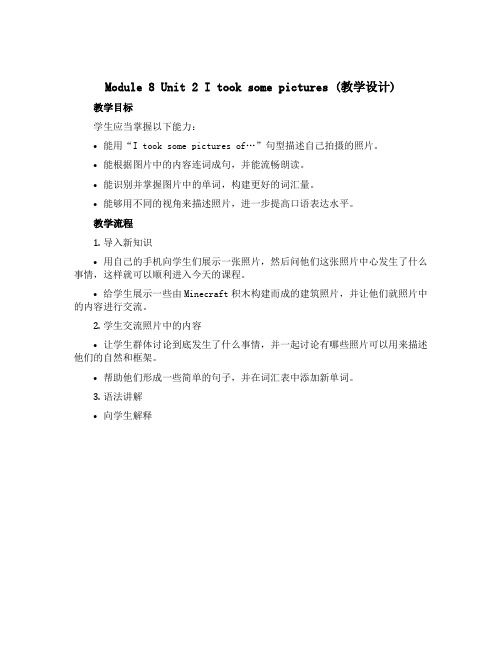
Module 8 Unit 2 I took some pictures (教学设计)教学目标
学生应当掌握以下能力:
•能用“I took some pictures of…”句型描述自己拍摄的照片。
•能根据图片中的内容连词成句,并能流畅朗读。
•能识别并掌握图片中的单词,构建更好的词汇量。
•能够用不同的视角来描述照片,进一步提高口语表达水平。
教学流程
1.导入新知识
•用自己的手机向学生们展示一张照片,然后问他们这张照片中心发生了什么事情,这样就可以顺利进入今天的课程。
•给学生展示一些由Minecraft积木构建而成的建筑照片,并让他们就照片中的内容进行交流。
2.学生交流照片中的内容
•让学生群体讨论到底发生了什么事情,并一起讨论有哪些照片可以用来描述他们的自然和框架。
•帮助他们形成一些简单的句子,并在词汇表中添加新单词。
3.语法讲解
•向学生解释。
Module8 Unit1 I took some pictures(教案)-2022-2023学年
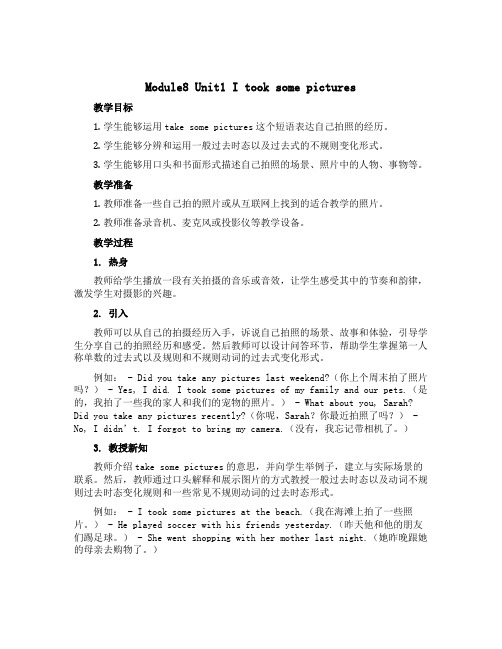
Module8 Unit1 I took some pictures教学目标1.学生能够运用take some pictures这个短语表达自己拍照的经历。
2.学生能够分辨和运用一般过去时态以及过去式的不规则变化形式。
3.学生能够用口头和书面形式描述自己拍照的场景、照片中的人物、事物等。
教学准备1.教师准备一些自己拍的照片或从互联网上找到的适合教学的照片。
2.教师准备录音机、麦克风或投影仪等教学设备。
教学过程1. 热身教师给学生播放一段有关拍摄的音乐或音效,让学生感受其中的节奏和韵律,激发学生对摄影的兴趣。
2. 引入教师可以从自己的拍摄经历入手,诉说自己拍照的场景、故事和体验,引导学生分享自己的拍照经历和感受。
然后教师可以设计问答环节,帮助学生掌握第一人称单数的过去式以及规则和不规则动词的过去式变化形式。
例如: - Did you take any pictures last weekend?(你上个周末拍了照片吗?) - Yes, I did. I took some pictures of my family and our pets.(是的,我拍了一些我的家人和我们的宠物的照片。
) - What about you, Sarah? Did you take any pictures recently?(你呢,Sarah?你最近拍照了吗?) - No, I didn’t. I forgot to bring my camera.(没有,我忘记带相机了。
)3. 教授新知教师介绍take some pictures的意思,并向学生举例子,建立与实际场景的联系。
然后,教师通过口头解释和展示图片的方式教授一般过去时态以及动词不规则过去时态变化规则和一些常见不规则动词的过去时态形式。
例如: - I took some pictures at the beach.(我在海滩上拍了一些照片。
) - He played soccer with his friends yesterday.(昨天他和他的朋友们踢足球。
Module8_Unit2_I_took_some_pictures教学设计

Module8 Unit2 I took some pictures.教学内容分析本模块的教学内容是谈论和评价过去的行为。
本单元的课文情境是Daming向妈妈介绍这次野餐的情形。
他告诉妈妈这次野餐玩得很开心:他们做了游戏,吃了很多好吃的东西,喝了果汁和牛奶,他还拍了很多照片,制作了一张海报。
妈妈表扬了Daming。
教学目标1、全体学生能认读took,tell,great,made并运用;全体学生能理解took,tell,great,delicious,made,poster,部分学生能运用delicious,poster2、全体学生能听懂、会说I took some pictures.3、全体学生能够运用一般过去时谈论和评价过去的行为。
4、全体学生能够积极运用所学英语进行表达和交流,乐于感知并积极尝试使用英语。
教学重难点不规则动词的过去式教学过程Lead in1、Greeting2、Warming up(1)Brain stormingRead the words or the phrases quickly and loudly.(2)Let’s sing a song <What did you do?> and do the actions.(设计意图:快速复习动词过去式及动词过去式短语,复习句型What did you do?及回答。
)3、Lead inI took some pictures last weekend.What did you do last weekend?Look at Daming ,can you guess what did Daming do?Today we’ll learn Module8 Unit2 I took some pictures.4、Watch a video<Peppa pig’s picnic>5、GroupDo you want to have a picnic? Today we have two groups. We’ll get lots of delicious food for our picnic. Let’s PK. Ready?(设计意图:观看小猪佩奇的视频,引入Picnic主题,带入情境并分组加入竞争机制)Presentation1、Last Sunday,Daming had a picnic too.Let’s have a look.(1)Watch and answer.What did Daming do on picnic?( D )A.He played games.B.He ate lots of delicious food.C.He took some pictures.D.A BC(2)NewBoys and girls ask Daming,listen to the voice.Read the sentence after the voice .Then study the new words.(3)Listen and repeat,then circle the past tense of verb.(4)Role playIt’s role play time,I’ll give you one minute.Work in pair,clear?(5)Fill in the blanks.Mum:Tell me about your picnic.Daming: It was .We games.We lots of delicious food.I some pictures and I a poster.Mum:That’s great!(6)The simple past tense(微课)(设计意图:学习单词和课文,词不离句,再通过多种角色扮演、填空、复述课文等多种练习,更好的掌握课文。
Module 8 Unit 2 I took some pictures(教案)-2022-2023

Module 8 Unit 2 I took some pictures(教案)教学目标1.让学生能够运用所学知识,准确、流畅地表达自己所拍到的照片。
2.培养学生对自然环境和自己生活的观察能力,激发其对生活的热爱和对美好事物的向往情感。
3.建立学生团队合作精神,让学生在团队互动中增进友谊、增长知识。
教学重难点1.重点:学生能够准确表达所拍摄照片的内容和感受。
2.难点:学生如何运用所学语言、知识表达自己的想法。
教学准备1.手机或其他拍照设备。
2.老师需要事先准备一些照片和相关的词汇图片,以供学生参考。
教学步骤Step 1 导入新课老师播放一段短视频,让学生观看多幅有趣的图片,并了解每幅图片所拍摄的内容,为后续学生自己拍照做好充分的准备。
Step 2 学生自己动手拍照学生接下来的任务是自己带着手机去拍摄自己感兴趣的照片。
照片的主题可以是公园中的自然景观、校园中的特别建筑、街头上的各色人物等等。
Step 3 学生描述自己所拍的照片学生们一一讲述自己所拍摄的照片,侧重描述照片中所见所闻、感受,因此需要一些语言的积累,老师可以在这里给学生讲解一些与所拍摄照片相关的词汇,如:tree, lake, bench, flower, bird等。
Step 4 小组互动把学生分为小组,让小组内的学生讨论自己所拍摄的照片,再举出一两个有代表性的来介绍,同时还需要互相补充和提出问题。
此环节旨在提高学生彼此合作能力和学生口语交际水平,并让学生感受集体讨论的乐趣。
Step 5 语言拓展老师按照自己的教学书籍所规定的语言项目,延伸教授其他方面的语言运用,如数词、词汇、短语等。
Step 6 总结检验教师进行总体检验,帮助学生巩固所学语言和知识点。
教学反思这是一个比较自由的课程,它充满了想象空间和机会,同时又能帮助学生实践和巩固所学知识,互相推销自己以及学生之间的团队合作等多种价值。
同时老师也可以根据学生的兴趣爱好制定更多更有意义的活动,让学生在参与锻炼自己的同时对学科知识产生更深刻的理解。
外研版九上module 8 photos unit 3 language in usewo
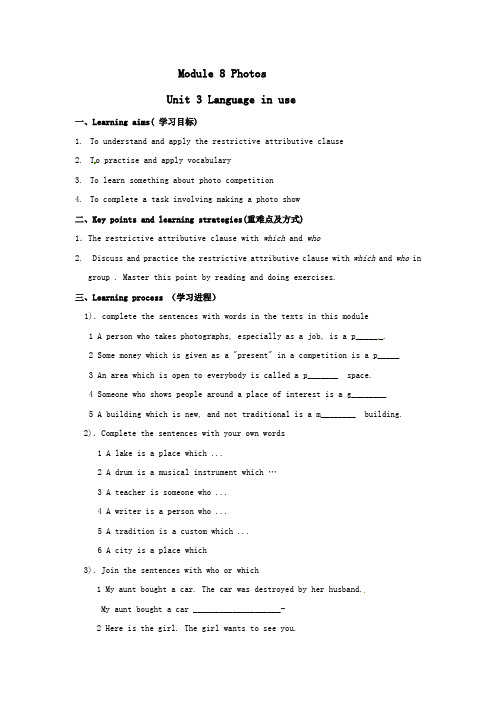
Module 8 PhotosUnit 3 Language in use一、Learning aims( 学习目标)1.To understand and apply the restrictive attributive clause2.T o practise and apply vocabulary3.To learn something about photo competition4.To complete a task involving making a photo show二、Key points and learning strategies(重难点及方式)1.The restrictive attributive clause with which and who2. Discuss and practice the restrictive attributive clause with which and who ingroup . Master this point by reading and doing exercises.三、Learning process (学习进程)1).complete the sentences with words in the texts in this module1 A person who takes photographs, especially as a job, is a p______.2 Some money which is given as a "present" in a competition is a p_____3 An area which is open to everybody is called a p_______ space.4 Someone who shows people around a place of interest is a g________5 A building which is new, and not traditional is a m________ building. 2).Complete the sentences with your own words1 A lake is a place which ...2 A drum is a musical instrument which …3 A teacher is someone who ...4 A writer is a person who ...5 A tradition is a custom which ...6 A city is a place which3).Join the sentences with who or which1 My aunt bought a car. The car was destroyed by her husband.My aunt bought a car ____________________-2 Here is the girl. The girl wants to see you.Here is the girl_____________________________3 I am the only student. I can run faster than Peter.I am the only student___________________________-.4 Yesterday we bought a book. The book is really hard to understanYesterday we bought a book______________________5 Is this the play? We will see the play next month.Is this the play_____________________________4).Work in pairs and look at the photos. Say how you :think cameras have changedSince their earliest beginnings.5).Listen and choose the best answer.1 When was the first succe ssful photograph produced?a) In the 17th century.b) In the 18t h century.c) In the 19th century.2 Why did people in the early photos not smile?a) Because there were no good photographers.b) Because it took a long time to take a photo.c) Because they were too frightened to smile.3 Compared with earlier cameras, how was the 1888 Kodak camera?a) It was more difficult to use.b) It was cheaper.c) It was bigger.4 What is the main difference between digital cameras and other cameras?a) Photos are smaller and lighter.b) There is no need to print the photos.c) They can be used by anyone; not only professional photog raphers.5 How heavy was the 1888 Kodak camera?a) 0.5kg b) 1.0 kg c) 115kg.6).定语从句练习1. He is the most careful boy _____ I know.A. whatB. whichC. asD. ./2. This is the school _____ Mr. Smith once taught.A. in thatB. whenC. whereD. there3. Have you visited the house _____ the famous scientist was born?A. whereB. in thatC. thatD. which4. The factory _____ Mr. Li used to work was closed last week.A. whenB. whereC. thatD. which5. Do you still remember the day _____ we first met?A. thatB. whenC. whatD. on that6. October 1,1949 is the day _____ we’ll never forget.A. whenB. thatC. whereD. in which7. Octobe r 1,1949 was the day _____ the People’s Republic of China was founded.A. whichB. whenC. whereD. in which8. Is this the shop _____ sells children’s clothing?A. whichB. whereC. in whichD. what9. Is this museum _____ they visited last month?A. thatB. whichC. whereD. the one10. I still remember the sitting-room _____ my mother and I used to sit in theevening.A. whatB. whichC. thatD. where11. Have you seen the girl _____?A. that I toldB. I told you ofC. whom I toldD. I told of12. The days are gone _____ we use “foreign matches”.A. during whenB. during thatC. on whichD. during which13. Finally the thief handed in everything _____ he had stolen to the police.A. whichB. thatC. whatD. whatever14. The lecture spoke of some writers and novels _____ were known to us all.A. whichB. thatC. whoD. what15. I can still remember the sitting room _____ my mother and I used to sit intheevening.A. whatB. whichC. thatD. where16. It was raining hard, _____ kept us indoors.A. whichB. thatC. asD. what17. The only question _____ is to find our way home.A. that matteredB. that mattersC. which matteredD. matter18. In the dark street, there was n’t a single perso n _____ she could turn forhelp.A. thatB. whoC. from whomD. to whom19. The farmers used wood to build a house _____ grain can be stored.A. with whichB. whereC. in thatD. which答案:1)6)1-5 DCABB 6-10 BBADD 11-15 BDBBD 16-19 ABDB。
九年级英语上册 Module 8 Photos Unit 1 It’s the band which

九年级英语上册Module 8 Photos Unit 1 It’s the band which gets everyone dancing精品教案外研版●Teaching Objectives1.To detect and foster the students’ listening and speaking skills (skill)2.To master the useful words and expressions(knowledge)3.To help the students learn more about different lives in our daily life fromdifferent photos(emotion)●Teaching difficult and key pointsTo let the students know something about the Blue band, and practise making dialogue about photos.●Teaching approachCommunicative teaching●Teaching toolsBlackboard&OHP&Radio●Teaching procedureTask 1: Show some photos about entertainment, sports, culture, nature beauty, and lead in the topic of photos. Then learn the new words of this unit. Through matching the new words and their meanings, let the Ss master the new words in class. And I can check if they have previewed the new knowledge well.Task 2: Let the Ss guess what are the people doing in this photo, then listen to the tape for the first time and finish Activity 1, 2. Then check and call back the answers. This part can check if the Ss can understand the whole dialogue. There are also some useful expressions for the Ss to master. Through some practice, the teacher can check if they have mastered.Task 3: Listen to the tape again and do Activity 4, 5. Then check and call back the answers. This part can give the Ss some deeply practice of the whole dialogue. Task 4: Let the Ss finish the Activity 6 by themselves. Then check and call back the answers.Task 5: Work in pairs, choose a photo to talk about and finish Activity 8. Then check and call back the answers.。
(九年级英语教案)Module8Photos

Module8Photos九年级英语教案module 8 photos教材分析本模块以摄影比赛为话题,介绍了托尼为参加摄影比赛而拍照的经历和上届摄影比赛的结果公示。
摄影比赛不是每个学生都参加过,但这一话题却为学生所熟悉和他们的日常学习生活相关,能够激发学生养成观察生活,发现生活的欲望。
有利于教学活动的设计和实施。
本模块通过介绍和摄影有关的内容展示了定语从句的用法。
在module 7学习that引导的定语从句基础上,继续学习which ,who 引导的定语从句。
中考说明要求:理解定语从句的构成和基本用法.只要求学生会辨认和理解定语从句的意思,但是对于程度比较好的学生,还是要初步掌握who/which引导的定语从句的用法,为学生的今后的学习奠定良好的基础。
教学目标1.语言知识目标:vocabulary : 2 trouble , 2 kid (n.), 3 expect , 2 size , 3. include , 2 rich , 2 present (n.& vt. ), (3 move) movement, (3 history) historic , (3 photograph)photographer, beauty , category, shot, feature, frightened , ceremony, congratulation,phrases:on the left / right ,pick up,even though , be pleased with , manage to do , make sth adj. ,agree to do ,find out, try out, by the way, at the end of, thanks to, congratulations to,500 meters wide, from…to…grammar: the restrictive attributive clause with which and who2.语言技能目标:听:能够听懂包含定于从句的句子;理解信息。
四年级英语下册教案-Module 8 Unit 2 I took some pictures.(4)
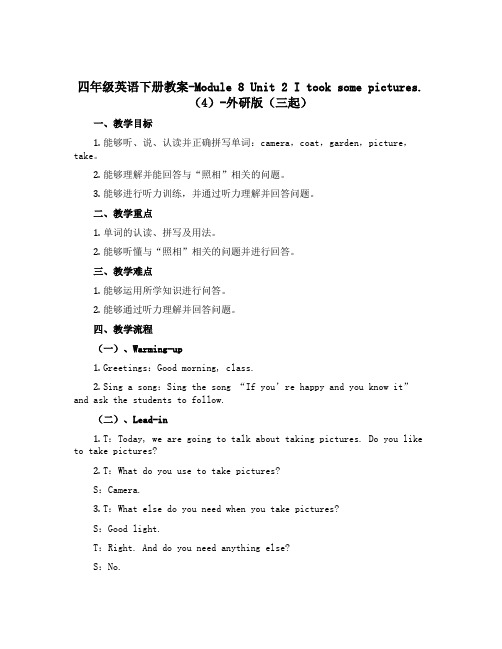
四年级英语下册教案-Module 8 Unit 2 I took some pictures.(4)-外研版(三起)一、教学目标1.能够听、说、认读并正确拼写单词:camera,coat,garden,picture,take。
2.能够理解并能回答与“照相”相关的问题。
3.能够进行听力训练,并通过听力理解并回答问题。
二、教学重点1.单词的认读、拼写及用法。
2.能够听懂与“照相”相关的问题并进行回答。
三、教学难点1.能够运用所学知识进行问答。
2.能够通过听力理解并回答问题。
四、教学流程(一)、Warming-up1.Greetings:Good morning, class.2.Sing a song:Sing the song “If you’re happy and you know it” and ask the students to follow.(二)、Lead-in1.T:Today, we are going to talk about taking pictures. Do you like to take pictures?2.T:What do you use to take pictures?S:Camera.3.T:What else do you need when you take pictures?S:Good light.T:Right. And do you need anything else?S:No.T:What if it’s cold, what do you need?S:A coat.T:Great. Do you like to take pictures in the garden?S:Yes.T:So today, we are going to learn Unit 2 of Module 8. The unit is called。
Module8Unit1Lookingatphotos教案
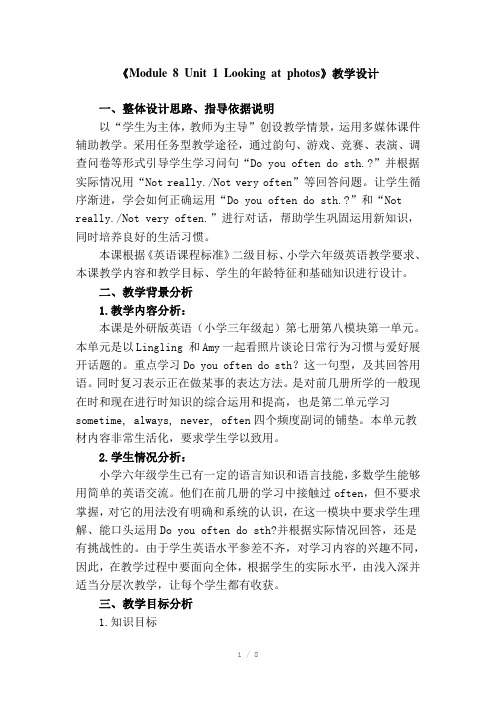
《Module 8 Unit 1 Looking at photos》教学设计一、整体设计思路、指导依据说明以“学生为主体,教师为主导”创设教学情景,运用多媒体课件辅助教学。
采用任务型教学途径,通过韵句、游戏、竞赛、表演、调查问卷等形式引导学生学习问句“Do you often do sth.?”并根据实际情况用“Not really./Not very often”等回答问题。
让学生循序渐进,学会如何正确运用“Do you often do sth.?”和“Not really./Not very o ften.”进行对话,帮助学生巩固运用新知识,同时培养良好的生活习惯。
本课根据《英语课程标准》二级目标、小学六年级英语教学要求、本课教学内容和教学目标、学生的年龄特征和基础知识进行设计。
二、教学背景分析1.教学内容分析:本课是外研版英语(小学三年级起)第七册第八模块第一单元。
本单元是以Lingling 和Amy一起看照片谈论日常行为习惯与爱好展开话题的。
重点学习Do you often do sth?这一句型,及其回答用语。
同时复习表示正在做某事的表达方法。
是对前几册所学的一般现在时和现在进行时知识的综合运用和提高,也是第二单元学习sometime, always, never, often四个频度副词的铺垫。
本单元教材内容非常生活化,要求学生学以致用。
2.学生情况分析:小学六年级学生已有一定的语言知识和语言技能,多数学生能够用简单的英语交流。
他们在前几册的学习中接触过often,但不要求掌握,对它的用法没有明确和系统的认识,在这一模块中要求学生理解、能口头运用Do you often do sth?并根据实际情况回答,还是有挑战性的。
由于学生英语水平参差不齐,对学习内容的兴趣不同,因此,在教学过程中要面向全体,根据学生的实际水平,由浅入深并适当分层次教学,让每个学生都有收获。
三、教学目标分析1.知识目标(1) 听、说、认读单词和短语:often, clean, play with, clean your room, read books, read stories.(2)听、说、认读“Do you often …?”Yes,I do. “Not really. Not very often等句子。
九年级英语上册 Module8 Photos教案 外研版 教案
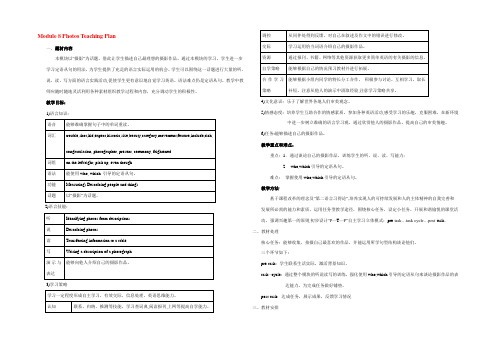
Module 8 Photos Teaching Plan一、题材内容本模块以“摄影”为话题,借此让学生描述自己最理想的摄影作品。
通过本模块的学习,学生进一步学习定语从句的用法。
为学生提供了充足的语言实际运用的机会。
学生可以围绕这一话题进行大量的听、说、读、写方面的语言实践活动,促使学生更有意识地自觉学习英语。
语法难点仍是定语从句。
教学中教师应随时随地灵活利用各种素材组织教学过程和内容,充分调动学生的积极性。
教学目标: 1)语言知识:2)语言技能:3)学习策略4)文化意识:乐于了解世界各地人们审美观念。
5)情感态度:培养学生互助合作的情感素质。
参加各种英语活动,感受学习的乐趣,克服困难,在新环境中进一步树立准确的语言学习观,通过欣赏他人的摄影作品,提高自己的审美情趣。
6)任务:能够描述自己的摄影作品。
教学重点和难点:重点:1.通过谈论自己的摄影作品,训练学生的听、说、读、写能力;2. who,which 引导的定语从句。
难点: 掌握使用who,which 引导的定语从句。
教学方法:基于课程改革的理念及“第二语言习得论”,培养实现人的可持续发展和人的主体精神的自我完善和发展所必需的能力和素质,运用任务型教学途径,围绕核心任务,设定小任务,开展和谐愉悦的课堂活动,强调兴趣第一的原则,初步设计“P—T —P”自主学习立体模式:pre-task…task -cycle…post -task 。
二、教材处理核心任务:能够收集、拍摄自己最喜欢的作品,并能运用所学句型结构谈论他们。
三个环节如下:pre-task :学生联系生活实际,激活背景知识。
task –cycle :通过整个模块的听说读写的训练,强化使用who,which 引导的定语从句来谈论摄影作品的表达能力,为完成任务做好铺垫。
post-task :达成任务,展示成果,反馈学习情况 三、教材安排根据学生学习英语的特点和规律,我们把本模块划分为4课时:Period 1: Vocabulary and Listening &Pronunciation and SpeakingPeriod 2: ReadingPeriod 3: Writing& Around the world &Module TaskPeriod 4: Language in use注:教学时应根据学生的学习水平、生活实际水平、接受程度及课堂出现的临时状况进行运用、调整及筛选。
Module 8 Photos第一单元教案

Module 8 PhotosUnit 1 It’s the band which gets everyone dancing Teaching steps:Step1. Listen and answer.Play the music and ask: What kind of music is it ?Step2. Let’s discuss1..Look at the picture and ask the following questions.1)What are they doing ?2)What is the man on the left doing ?3)What is the man on the right doing?2.Let the students discuss in groups.3.Play the tape for the students to check answers.Step3.Learn the new words1.Ask the students to read them first.2.Read after the teacher.3.Learn the words by heart.Step4.Listening comprehension.Play the tape for the students to listen and answer:Who’s He Zhong ?Step5.Listen and checkPlay the tape and check the answers of activity 1.Step6.Read and fill in the blanks1.Ask the students read and fill in the blanks2.Check the answers.Step7.Everyday EnglishStep8.Answer the questions (Activity 6)Step9. Competition1.Find out the Attributive Clauses in the dialogueHave a competition between boys and girls.2.Ask the students to tell the difference between “which”and “who”3.Give notesplete the passage with “which ” and“who”.Step11.Talk about the picture with “which”and “who”.Step12.Homework.Write a passage about your favourite photo with “who”and “which”.花桥中学楼荷莲感谢您的阅读,祝您生活愉快。
第七册Module 8 教学设计

第七册Module 8 教学设计Module 8 unit 1 Looking at photos.台吉镇英语组教师Teaching aims:1. 知识目标:a)能听/说/读并正确使用单词:often,clean,b)能理解并灵活掌握句型:Do you often ……?Yes,I do./No,I don’t./Not really./Not very often./Do you like reading books now?2. 技能目标:一方面,继续扩展学习讨论喜好及日常行为的话题。
另一方面,我们要复习巩固一般现在时等以前学习的内容,比较某人日常行为与正在做的事情的差异。
3. 情感态度:通过多种形式的教学活动,激发学生学英语的兴趣,用“Do you often ……?”询问别人的日常行为。
引导他们积极参与小组活动.4. 学习策略:通过“小组合作学习”方式, 提高团体协作和运用语言的综合能力,最大限度地调动和发挥学生的内在潜力,进行语言知识的主动练习和运用。
Teaching important tents:能理解并掌握句型:Do you often play with dolls? Do you often clean your room?以及Do you like reading books now ?Teaching difficult tents:理解并灵活使用短语“stopped a long time ago ,not really ,not very often” 。
Teaching methods: 用Do you often ……?调查同学们的喜好以及日常行为。
Teaching tools: 图片、CD-ROM、PPT。
Teaching procedure:Step 1:warm up1. Greetings.2. Sing and say the chants.3. Review the verb phrases.Step 2:lead-in.1. New word“often”T:Do you want to know what I do in a week?S:Yes.T:Yes,I’d love to.(read aft er T).T:Look,Here it is.This is my activities in a week.I……on Sunday.And I……on Sunday.I……on Monday.So I often…….出示often.拼读单词.2. Make sentences with “often”.3. T:Do you often……?Ss:Yes,I do.4.(师生互问)引出Do you often….?的几种问答.5.(生生互问)Do pairwork.(two by two)Step3:Presentation and drilling.a).First listen to the tape and find out“often”,and underline the word.b).Listen and repeat and choose True of False.1)Lingling wants to see Amys photos.2)Amy often plays with dolls.3)A my doesn’t often read stories.4)Amy often cleans her room.5)Lingling often cleans her room.c)Listen and repeat again,then answer the questions.1)What are Amy and Lingling doing?2)How many photos are they talking about?3)Does Amy often play with dolls?4)Does Amy often read stories?5)Does Lingling often clean her room?Step 4:Finish the surveyUse“Do you often…?”to ask other people in the classStep 5:Homework.1)Make two or four sentences with “often”.2)Make a survey with your family.3)Read Module 8 unit 1 five times.Module 8 Unit 2 I often go swimming 1.Teaching aims(1)Words: students must understand new word , and remember always, never.(2) Sentences: students can use do you often---? To talk about others’ habits. Studentscan use I always\ often \sometimes\ never---. And She always \often\ sometimes\ never ---.(3) Grammar: students can understand always\ often\ sometimes\ never and the General tense.(4)Abilities : students can use always\ often\ sometimes\ never. Talk about own and other people’s habits.(5)Emotion: know own and other people’s habits, to get on well with together.2.Teaching important tents(1)Words: always, often, sometimes, never(2)Sentences: Do you always\ often\ sometimes\ never---?I always\ often\ sometimes\ never---.He\ She always\ often\ sometimes\ never---.(3)Grammar: the general continue tense3. Teaching difficult tentsHow to read always , never, how to use always, often, sometimes, never.4.Teaching toolsCAI, recorder, stickers, exercise books5. Teaching methods(1)Say the chant together.(2)Have a brain storm.(3)Practice in pair.(4) Have a press conference.(5)Talk about own activities.(6)Listen to the tape.(7)Make a survey.6.Teaching procedureStep 1. Warming upSay the chant and do actions.Step 2. Presentation(1)Show some pictures and say,which group can say most phrases.(2)T: I have lots of hobbies. Reading English books is my hobby. Look at this picture. What’s he do ing?S1: He’s reading English books.T: Do you always read English books?S2: Yes, I do. \Yes, of course.\ No, I don’t .\ Not really.Teach always.Then show write stories.T: What’s he doing?S1:---.T:I often write stories. Do you often write stories?S3: ---.Teach often.Show the picture of playing football.T: I like playing football. Do you like playing football?S1:---.T: Do you sometimes play football?S1:---.Teach sometimes.Show the picture of cleaning the blackboard.T: What’s she doing?S1: She is cleaning the blackboard.T: I never clean the blackboard. Do you never clean the blackboard?S2: ---.Teach never.(3)Show some pictures , students practice in pairs, then show.(4)Make a press conference.Today we will meet four famous people. Guess it who they are .Welcome Xiyangyang , Meiyangyang, Huitailang, Hongtailang.First, introduce and say hello.Second , Xiyangyang says : today we have a press conference, if you have some questions, please ask.Third, teacher makes an example like this:T: Hello, Xiyangyang.Do you always watch TV?X: ---.T: Thank you.Then students begins to ask. Which group ask more?Step 3. Listening(1)Look at my activities in a week. Teacher says: I always\ often\ sometimes\ never---. Explain them , then do exercise.(2)Take out own charts , then say like this: I ---.(3)Listen to the tape and number the picture. Then show the pictures to check the answers.(4)Listen to the tape and fill in the blanks.Xiaoyu__________ reads English books.Heping __________ writes stories in English.Maomao ___________ plays football.Lili ______________ clean the blackboard.Lingling ___________ goes swimming.Daming ____________ eat with a knife and fork.Simon ______________ rides bikes to school , he ________ goes by bus.Check with listening material.Step 4. Production(1)Take out the chart, we will have a survey.(2)Teacher make an exampleT: What do you do at the weekend?S: I always\ often \ sometimes\ never---.T: Do you ----?S: Yes, I always\ often\ sometimes---.No, I never---.(3)Students begins to serve. Then fill in the blanks.(4) Write a short passage, then give a report.Step 5. Homework: Ask your family, then write down.。
Module8TeachingPlan
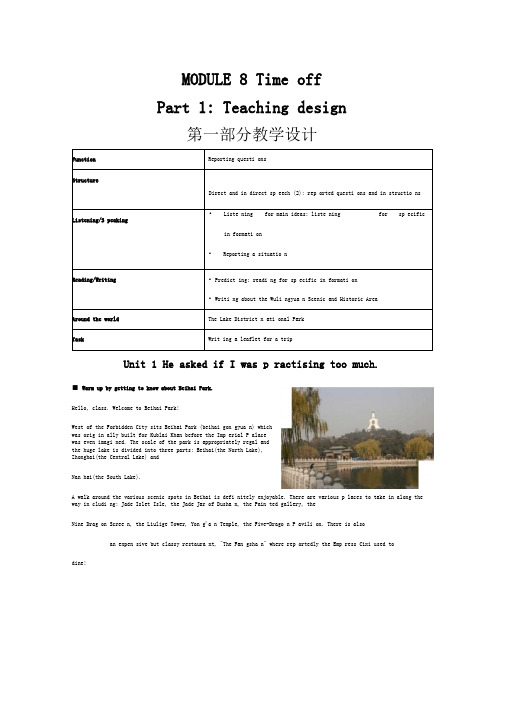
MODULE 8 Time offPart 1: Teaching design第一部分教学设计Function Reporting questi onsStructureDirect and in direct sp eech (2): rep orted questi ons and in structio ns•Liste ning for main ideas; liste ning for sp ecific Listening/S peakingin formati on•Reporting a situatio nReading/Writing• Predict ing; readi ng for sp ecific in formati on• Writi ng about the Wuli ngyua n Scenic and Historic AreaAround the world The Lake District n ati onal ParkTask Writ ing a leaflet for a tripUnit 1 He asked if I was p ractising too much.■ Warm up by getting to know about Beihai Park.Hello, class. Welcome to Beihai Park!West of the Forbidden City sits Beihai Park (beihai gon gyua n) whichwas orig in ally built for Kublai Khan before the Imp erial P alacewas even imagi ned. The scale of the park is appropriately regal andthe huge lake is divided into three parts: Beihai(the North Lake),Zhonghai(the Central Lake) andNan hai(the South Lake).A walk around the various scenic spots in Beihai is defi nitely enjoyable. There are various p laces to take in along the way in cludi ng: Jade Islet Isle, the Jade Jar of Dusha n, the Pain ted gallery, theNine Drag on Scree n, the Liulige Tower, Yon g'a n Temple, the Five-Drago n P avili on. There is alsoan expen sive but classy restaura nt, "The Fan gsha n" where rep ortedly the Emp ress Cixi used todine!Beihai is a p eaceful p lace to wan der and do some people watch ing. In summer, some ignore the No-swim ming sig ns and dive into the lakes. In win ter, skati ng is a popu lar pu rsuit.Lege nd: The origi nal desig n for the park origi nates from an ancient tale. Chin ese lege nd has it that there were three islands across the eastern seas where fairies and immortals lived: Penglai, Yingzhou andFangzhang. The celestial beings in habit ing these isla nds inven ted a won derful p ill that made huma ns immortal. (Imag ine an an cie nt Viagra and you get the scale of the craze). Emp eror Qin gshihua ng and Emp eror Han wudi sent messengers across the seas in search of these wonderful pills, but the messengers never returned. The Chinese emperors were forced therefore, to settle for something less. They con structed their own fairyla nd in the lake n ear their P alace as a comfort to themselves and their un-realizeddreams of being immortal.■ Learn about sentence types.Type 1. He is a teacher. He looks like a teacher.主语 + 系动词 + 表语1. They're beh ind us.2.She's hurt too badly.Type 2. He runs.主语+不及物动词 Betty, why are you stopping?Type 4. He teaches us English.主语+及物动词+间接宾语+直接宾语 1. I ' m iving her something to drink. 2. Can you get some help?Type 5. He makes us happy.主语+及物动词+宾语+宾语补足语 1. I can hear some one shout ing.2. What happened?3. Can she walk? Type 3. He writes books.主语+及物动词+宾语 1. I ' msliening for Lingling and Tony. 2. They'll catch up with us. 3. She says her leg is very sore. She's crying.4.rm tak ing care of her.1.2. rm kee ping her warm.3.Take it easy.Type 6. There is a book on the table.谓语(there be)+ 主语+ 状语■ Listen and read.On p age 56 in the box is a dialogue. Lin gli ng and Sally are talk ing about Beihai Park.Before we listen to it, let ‘go on to read it first. While reading, try to: cut/ the sentence into thought groups, study the predicative, darken the connectives and underline all the usefulexpressions.(阅读过程中,断开/意群,观察谓语构成,圈出连词,摘录短语搭配。
图片运用:如何利用图片辅助Module8教案教学?2

图片运用:如何利用图片辅助Module8教案教学?2。
一、图片如何帮助模块8教案教学?模块8是一个十分重要和复杂的模块,涵盖多个学科,教学内容也十分繁杂。
在如此复杂和具有挑战性的教学过程中,教师可以灵活运用图片,好比我们人的大脑会对图像进行更快的识别和理解,并且通过与文字相结合使得知识点变得更加生动丰富,这将大大增强学生的记忆和理解,同时激发学生的学习兴趣,增加知识记忆和理解的持久性,深入了解世界的多方面内容。
1.图片体现文化差异在模块8教学中,可以利用图片来呈现不同的文化差异,增强跨文化交流和交流的因素。
例如,在介绍英语国家的传统节日时,可以配合图像来介绍节日的起源、庆祝方式、情感和意义等。
在图像中查看或制作一些英文节日提示图片,这将使教师的语言更加生动有趣,加强学生的文化理解。
2.图片优化词汇教学图片可以扩大学生的语言知识,特别是在术语和词汇方面,因为图片可以帮助学生更好地理解单词的意思、应用场景及发音方式。
通过图片帮助学生快速记忆词汇,加深对不同单词之间的区别和联系等认识,这样就可以在快速且有效的学习过程中加强学生对于英语单词的理解,提高整体词汇教学效果。
3.图片提高阅读与写作能力在模块8教学中,配合课本内容让学生进行阅读和写作时,插入一些图片也会对他们的作文成绩产生积极影响。
这样做的好处是增加学生的理解力和知识储备,促进学生创造性思维,提高学生的写作水平。
二、如何运用图片提高模块8教学效果?为了充分利用图片资源,教师可以运用以下方法:1.使用教学支援软件来制作图像现在,有许多免费和收费的软件可以在教学中处理图像。
例如,PPT、Adobe Photoshop、GIMP和Canva等都是非常好用和好看的软件,可以让教师通过简单的拖放、插入和调整,即可大大提高制作效率。
这些获得的图片可以应用于幻灯片,墙纸和给定文件中,从而使教学内容变得更具体和清晰2.使用部分互动式教案使用一些互动式教案设计,可以帮助学生更深入地理解课程内容。
- 1、下载文档前请自行甄别文档内容的完整性,平台不提供额外的编辑、内容补充、找答案等附加服务。
- 2、"仅部分预览"的文档,不可在线预览部分如存在完整性等问题,可反馈申请退款(可完整预览的文档不适用该条件!)。
- 3、如文档侵犯您的权益,请联系客服反馈,我们会尽快为您处理(人工客服工作时间:9:00-18:30)。
Module 8 Photos Teaching Plan一、题材内容本模块以“摄影”为话题,借此让学生描述自己最理想的摄影作品。
通过本模块的学习,学生进一步学习定语从句的用法。
为学生提供了充足的语言实际运用的机会。
学生可以围绕这一话题进行大量的听、说、读、写方面的语言实践活动,促使学生更有意识地自觉学习英语。
语法难点仍是定语从句。
教学中教师应随时随地灵活利用各种素材组织教学过程和内容,充分调动学生的积极性。
教学目标:4)文化意识:乐于了解世界各地人们审美观念。
5)情感态度:培养学生互助合作的情感素质。
参加各种英语活动,感受学习的乐趣,克服困难,在新环境中进一步树立准确的语言学习观,通过欣赏他人的摄影作品,提高自己的审美情趣。
6)任务:能够描述自己的摄影作品。
教学重点和难点:重点:1.通过谈论自己的摄影作品,训练学生的听、说、读、写能力;2. who,which引导的定语从句。
难点:掌握使用who,which引导的定语从句。
教学方法:基于课程改革的理念及“第二语言习得论”,培养实现人的可持续发展和人的主体精神的自我完善和发展所必需的能力和素质,运用任务型教学途径,围绕核心任务,设定小任务,开展和谐愉悦的课堂活动,强调兴趣第一的原则,初步设计“P—T—P”自主学习立体模式:pre-task…task-cycle…post-task。
二、教材处理核心任务:能够收集、拍摄自己最喜欢的作品,并能运用所学句型结构谈论他们。
三个环节如下:pre-task:学生联系生活实际,激活背景知识。
task –cycle:通过整个模块的听说读写的训练,强化使用who,which引导的定语从句来谈论摄影作品的表达能力,为完成任务做好铺垫。
post-task:达成任务,展示成果,反馈学习情况三、教材安排根据学生学习英语的特点和规律,我们把本模块划分为4课时:Period 1: Vocabulary and Listening &Pronunciation and SpeakingPeriod 2: ReadingPeriod 3: Writing& Around the world &Module TaskPeriod 4: Language in use注:教学时应根据学生的学习水平、生活实际水平、接受程度及课堂出现的临时状况进行运用、调整及筛选。
『教学设计』Title: Module 8 PhotosPeriod 1: Vocabulary and Listening &Pronunciation and SpeakingAims and Demands:1) Key vocabulary: trouble,shot,kid,expect,on the left/right, pick up,2) Listening skill: To understand conversations involving talking about photos.Improve the students’ listening ability.3) Emotion &Attitudes:To help the students learn more about different livesin our daily life from different photos.difficult and key points:To let the students know something about the Blues band,and practise making dialogue about photos.approach: Communicative teachingstrategies: Bottom –up approach and listening to the tape and do some exercises. Aids: Multi-Media (or Tape recorder, OHP, Blackboard)Procedures:Step 1 RevisionTask 1: Recall what we have learned in Module 7.1. Label the pictures with the words and expressions.(1). Read through the words and expressions in the box and have the Ss. Repeatthem after you.(2).Ask them to label them in the pictures on the screen.(3).List some words which are connected with Australia. Ask students to speakout as many as they can.2. Tell something about Australia. Ask students to speak out as much as they can.Step 2 Lead inTask 2: Show some photos about entertainment, sport, culture, nature beauty, and lead in the topic of photos. Then learn the new words of this unit.1.Get them to enjoy some photos about entertainment, sport, culture, naturebeauty,2. Show them a picture of a concert.Let Ss guess what it is and what’s happingin this photo, then introduce the new words.3. Discuss the picture, using the words in the box in Activity 1.Step 3 Listen and readTask 3:Listen to the tape and finish Activity 2 . Then check and call back the answers.1.Play the recording while they just listen and focus on the words in Activity1.2. Have them check their answer with a partner and play the recording again.3. Check and call back the answer from the whole class.Task 4: Listen to the tape again and do Activity 4,5 . Then check and call back the answers.1 Show them the questions in Activity 4.2. Play the recording and have them listen to the recording and focus on thequestions in Activity 4.the recording again and have them write down the answers, then check witha partner.call back the answers from the whole class.5. Read the conversations in Activity 3. Make sure that Ss understand theconversation.plete the sentences in their own words Activity call back the answersfrom the whole class.Task 5: Let the Ss finish the Activity 6 by themselves. Then check and call back the answers.1. Show them the questions in Activity 6.them write down the answers, then check with a partner.check and call back the answers from the whole class.Task 6: Read1. Play the recording again and pause after each phrase, asking the Ss. torepeat chorally and individually.2. Put the Ss. into groups of 5 to practise the dialogue.3. They should repeat it several times, changing the roles each time. Step 4 PronunciationTask7: Listen and repeat the sentences in Activity7 on page 65. Make sure that theystress the underlined words.1. Ask the Ss to listen and repeat the sentences.2. Play the recording again. Ask the Ss to pay particular attention to theword stress.3. Ask the Ss to listen and repeat chorally and individually.Step 5 SpeakingTask 8: Work in pairs, choose a photo to talk about and finish Activity 8. Then check and call back the answers.each of them to choose a photo.them to work in pairs to share their descriptions.back some examples in a whole-class setting, paying special attention tothe use of the attributive clause guided by who \ which..Step 6 Homework1. Do &9 in the Wb.2. Oral work: Read the conversation of Activity3.3. Preview Unit2 in Module 8.Period 2 : ReadingAims and Demands:1)Language knowledge: historic, size, beauty, category, movement, feature, include, rich,congratulation, photographer, present, ceremony,photographer, present, ceremony,even though2) Reading skills: To detect and foster the students’ reading skills To getinformation from the reading material.3) Emotion &Attitudes:To help the students learn more about different livesin our daily life from different photos.difficult and key points: To let the students know something about photocompetition and learn something about thedifferences among entertainment, sport, culture,nature beauty photos.strategies: Communicative approach.Aids: Multi-Media (Tape recorder, OHP)Procedures:Step 1 RevisionTask1:Help students to revise what was learnt in Period1of this module.1. Show them some pictures about entertainment, sport, culture, nature beautyphotos.2. Have the Ss. talk about them.Step 2 PreparationTask2: Let the Ss preview the new words and make them build the conception of entertainment, sport, culture, nature beauty photos, then lead in the Activity 1.1. Show them some pictures about entertainment, sport, culture, nature beautyphotos.the Ss. talk about them.Task 3: Learn the new words, then label the pictures with the words.1. Read through the words on the screen. Have the Ss. Repeat them after you.2. Read the words separately and have them remember them.3. Make some sentences with the words.4. Call back the answers from the whole classStep 3 Scanning and SkimmingTask 4: Scan this passage, according to the content , finish Activity 3. Then check and call back the answers.the Ss to read the passage as quickly as possible.2. Do Activity 3 .Complete the table and write notes3. Call back the answers from the whole class.Step 4 ReadingTask5: Let the Ss read the passage by themselves in details, and do Activity 4.Then check and call back the answers.1. Read through the sentences in Activity 4.2. Read the passage by themselves. And ask to finish the true or false exercises.the answers with the whole class.Task6: Use the given words to find opposite words in each sentences, and finish Activity 5. Then check and call back the answers.1. Get the Ss to listen and repeat the passage simultaneously.2. Use the given words to find opposite words in each sentences,3. Get the students to correct the sentences..4. Call back the answers from the whole class.5. Language points in the passage.Task7: Finish Activity 6, Then check and call back the answers.1. Get the Ss to read the passage together loudly.2. Discuss the following questions in groups.1)“…read on to find out who the winners are.” where do you find who the winners are?2)“…the fun which their fans are having.” Why are the fans having fun?3) “It successfully shows the rich culture which makes Beijing so famous..”Who or what shows the rich culture?3. Share the ideas.Step 5 PairworkTask6:Finish Activity 7. Then check and call back the answers.1. Read through the table.2. Work in pairs. Ask and answer about the places.Ss to talk about the classroom.Step 6 Practice1. Do Exercise 10 on page 142 in the WB.2.Give the students some time to recall what they’ve learned in this class.1.Read the text.2.Retell the text.Period 3: Writing & Around the world &Module TaskAims and Demands:1) Writing skill: To write something about a photo. Improve the students’ writingability .2) Reading skills: To get information from the reading material A famous photo.3)Emotion &Attitudes:To help the students learn more about different lives inour daily life from different photos.strategies:Top-down and Interactive approach and do some exercises.Aids: Multi-Media (Tape recorder, OHP)Procedures:Step 1 RevisionTask1: Help students to revise what was learnt in the last class.1. Revise the words and phrases.the Ss. retell the text.Step 2 Writing.Task2: Write sentences about their favorite photograph.1. Ask the Ss run through the questions in Activity 8 on Page67 and w ritesentences about their favorite photograph..2. Call back the answers from the whole class, having individuals read theirsentences.Task3: Write a short passage describing their favorite photograph1. Ask the Ss to do this individually.2. They can exchange it with a partner for peer correction.3. Have some students read their passage out to the whole class.Step 3 Around the worldTask4: Learn something about a famous photo.1. Ask the Ss.to look at the photo about the space. Tell the Ss. some knowledgeabout it.2. Read the text and answer any questions the Ss have.Step 4 Module TaskTask5: Making a photo show.1. Activity 10 on page 71. Ask the Ss. to write about their favorite photo,saying what /who it is and why it is important to them.2. Activity 11 on page their photo to their group. And tell others why theylike it and why it is important to them..Answer any questions their groupmay have. Listen to the other members of their group talk about their photos.3. Activity12 on page 71. Put all the photos on the table and talk about themin groups.Step4 RecallingRecall what we have learned today.1. Do on page 143.2. Do the Self-assessment on page 143.Period 4: Language in use1. Teaching Aims and Demands:1)To detect and foster the students’understanding of grammar skills (skill)2)To master the useful words and expressions(knowledge)3)To help the students learn more about different lives in our daily life fromdifferent photos(emotion)difficult and key points:To let the students know how to use “Which and Who ”to make attributive clauseapproach: Communicative teachingstrategies: Formal instruction and task-based approach and interactive practice. Aids: Multi-Media (recorder, OHP )Procedures:Step 1 RevisionHelp students to revise what is learnt in 3 periods of this module.Step 2 Listen and speakTask1:Look at the photos in Activity 8,then discuss them.Ss. to describe cameras in the photos.how you think cameras have changed since their earliest beginnings.Task2: Practise listening1. Ask the Ss. to listen to the conversation and do Activity 9 on page 70 individually.again and check with their partners.the answers back from the class.Step 2 WriteTask 3: Complete the passage using the correct form of the words and expressions in the box.1. Ask the Ss. to complete the passage using the correct form of the words andexpressions in the box in Activity 1 and Activity 7.2. Call the answers back from some students.Step 3 Language practiceTask4:To summarize and consolidate the attributive clause guided by who/which.1..Read through the examples with the Ss. and make sure that they are familiarwith the use of the attributive clause guided by who/which.2. Ask the Ss. to repeat the sentences in the box.3. Ask“Can you make other similar examples?”the Ss’ attention on the ways in which they are used:who/which.Task5: Do Activity2 and Activity 3 on page 68 individually.1. Ask the Ss. to check with a partner.2.. Ask the Ss. to read out the sentences.3. Summarize the use of the attributive clause guided by who/which.Task 6: Join the sentences with who or which.1. Ask the Ss. to do Activity 4 on page 69 individually.2. Call the answers back from some students.Task7: Use the knowledge of this module to make an instruction of Activity 5 .1. talk about the two pictures.2. Then talk about the people in the two pictures.3. Now ask questions about the picture, and write down their answers. Step 4 GuessTask8: A guessing game1. Look around the class and describe something to their partner, using theknowledge of this module.2. Guess who/what I am describing.Step 5 Homework:1. Finish all the exercises in the WB.2. Preview Module 9.。
